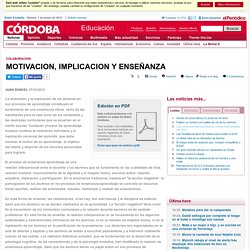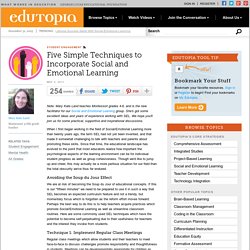

Redes 130: Aprender a gestionar las emociones - emociones. La curiosidad pone al cerebro en modo aprendizaje. MOTIVACION, IMPLICACION Y ENSEÑANZA - Educación. La motivación y la implicación de los alumnos en sus procesos de aprendizaje constituyen el fundamento de una enseñanza eficaz, tanto de las habilidades para la vida como de los contenidos y las destrezas curriculares que se enseñan en el medio escolar.

Cualquier proceso de aprendizaje humano conlleva la motivación intrínseca y la implicación personal del aprendiz, que debe conocer el motivo de su aprendizaje, el objetivo del mismo y disponer de los recursos personales para lograrlo. El proceso de enseñanza-aprendizaje es una relación interpersonal entre el docente y los alumnos que se fundamenta en las cualidades de toda relación humana: reconocimiento de la dignidad y el respeto mutuo, escucha activa, relación empática, implicación y participación. En esta forma de enseñar, las motivaciones, si las hay, son extrínsecas y la disciplina es externa, dado que los alumnos no se sienten implicados en el aprendizaje.
Rubrica Para Evaluar La Creatividad. TaxonomiaBloomCuadro. Adele diamond school readiness conference 2009 11 sp. 'I wish my teacher knew...': Young students share their 'heartbreaking' worries in notes - Education News - Education. An elementary school teacher who received 'heartbreaking' notes after she asked her students to share their worries, has inspired other teachers to use her trick and better understand their own pupils.

Kyle Schwartz, teaches a third grade class at Doull Elementary in Denver, Colorado. The majority of her students come from underprivileged homes, as 92 per cent are entitled to free or reduced school lunches, she told ABC News. “As a new teacher, I struggled to understand the reality of my students' lives and how to best support them.
I just felt like there was something I didn't know about my students,” she told the broadcaster. To tackle this problem, she asked her students to complete the sentence: “I wish my teacher knew…” While some children used the notes to jokingly complain about homework or to request more playtime, Ms Schwartz said some of the answers were “heartbreaking”, as children revealed the tough struggles they are facing. Five Simple Techniques to Incorporate Social and Emotional Learning. Note: Mary Kate Land teaches Montessori grades 4-6, and is the new facilitator for our Social and Emotional Learning group.

She's got some excellent ideas and years of experience working with SEL. We hope you'll join us for some practical, supportive and inspirational discussions. When I first began working in the field of Social/Emotional Learning more than twenty years ago, the term SEL had not yet been invented, and that made it somewhat challenging to talk with teachers and parents about promoting these skills. Since that time, the educational landscape has evolved to the point that most educators realize how important the psychological aspects of the learning environment can be for individual student progress as well as group cohesiveness.
Though we'd like to jump up and cheer, this may actually be a more perilous situation for our field than the total obscurity we've thus far endured. Avoiding the Soup du Jour Effect Technique 1: Implement Regular Class Meetings. El cerebro del bebe: Eduard Punset y Sue Gerhardt 1/6 redes. El lóbulo frontal: el director ejecutivo del cerebro. Introducción El lóbulo frontal es uno de los cuatro lóbulos de la corteza cerebral y constituye una región grande que está situada en la parte delantera del cerebro, justo detrás de la frente (ver figura 1). Es el responsable de procesos cognitivos complejos, las llamadas funciones ejecutivas. Estas funciones son operaciones mentales dirigidas hacia un fin que permiten el control conductual, es decir, posibilitan que podamos elegir, planificar y tomar decisiones voluntarias y conscientes.
Según Elkhonon Goldberg, el lóbulo frontal es al cerebro lo que un director a una orquesta: coordina y dirige las otras estructuras neurales del cerebro en una acción concertada1. Fig 1. (rojo), temporal (azul), parietal (verde) y occipital (amarillo)2. Developing Teachers' Social and Emotional Skills. Emotions are at the heart of what teachers do and why they do it.

Educators come to teaching with dreams of changing the odds for disadvantaged children, inspiring a love for learning, or developing critical thinkers. Unfortunately, research shows that 40-50 percent of teachers will leave the classroom within their first five years. Stress among teachers has reached unprecedented levels, and according to the latest MetLife Survey of the American Teacher (PDF), over half of teachers reported "great stress at least several days a week. " Teaching is an emotional practice, and teachers need support in strengthening their social and emotional skills to manage the stress that comes with teaching and stay in the profession for the long term.
Social and emotional competencies (SEC) are critical to avoid burnout and increase teacher well-being. Research has found that students learn better in safe, supportive environments. Why Should Teachers Develop Their SEC? 1. 2. 3. Try this.